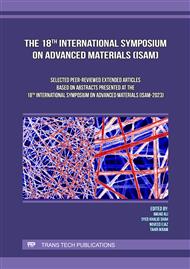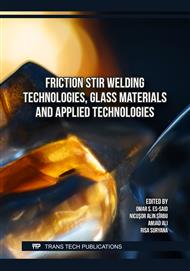[1]
T. Castiglione, F. Pizzonia, S. Bova, A novel cooling system control strategy for internal combustion engines. SAE International Journal of Materials and Manufacturing, 9 (2016)294-302.
DOI: 10.4271/2016-01-0226
Google Scholar
[2]
M.U. Yousaf, Automobile rear axle housing design and production process improvement using Failure Mode and Effects Analysis (FMEA). Engineering Failure Analysis, 154 (2023) 107649.
DOI: 10.1016/j.engfailanal.2023.107649
Google Scholar
[3]
K. M. Jadeja, R. Bumataria, N. Chavda, Nanofluid as a coolant in internal combustion engine–a review. International Journal of Ambient Energy, 44 (2023) 363-380.
DOI: 10.1080/01430750.2022.2127891
Google Scholar
[4]
C. Nadjahi, H. Louahlia, S. Lemasson, A review of thermal management and innovative cooling strategies for data center. Sustainable Computing: Informatics and Systems, 19 (2018) 14-28.
DOI: 10.1016/j.suscom.2018.05.002
Google Scholar
[5]
M. J. Ellsworth Jr, An overview of the IBM power 775 supercomputer water cooling system. (2012).
Google Scholar
[6]
L.Yong, K. Sumathy, Review of mathematical investigation on the closed adsorption heat pump and cooling systems. Renewable and Sustainable Energy Reviews, 6 (2002) 305-338.
DOI: 10.1016/s1364-0321(02)00010-2
Google Scholar
[7]
S. Peyghambarzadeh, Experimental study of heat transfer enhancement using water/ethylene glycol based nanofluids as a new coolant for car radiators. International communications in heat and mass transfer, 38 (2011) 1283-1290.
DOI: 10.1016/j.icheatmasstransfer.2011.07.001
Google Scholar
[8]
S.Z. Heris, Experimental study of heat transfer of a car radiator with CuO/ethylene glycol-water as a coolant. Journal of dispersion science and technology, 35 (2014) 677-684.
DOI: 10.1080/01932691.2013.805301
Google Scholar
[9]
A. Shabbir, Morphology matters: investigating the influence of granules and nanofibers on the physicochemical properties of TiO2 for optoelectronic applications. Optical Materials, 146 (2023) 114525.
DOI: 10.1016/j.optmat.2023.114525
Google Scholar
[10]
Z. Hussain , Corrosion behavior of MoSi2 coated Hastelloy X utilized in iodine-sulfur cycle for hydrogen production application. Solid State Phenomena, 336 (2022) 35-41.
DOI: 10.4028/p-g30x7e
Google Scholar
[11]
M. Kashif, A. Shabbir, Electric field-induced changes in photoluminescence and Raman spectra of MoS2 on PVA-coated conductive substrate with nematic liquid crystals: a combined numerical and experimental study. Journal of Materials Science: Materials in Electronics, 35 (2024) 954.
DOI: 10.1007/s10854-024-12714-1
Google Scholar
[12]
Z. Hussain, Corrosion behavior of SiC coated HX with MoSi2 interlayer to be utilized in iodine–sulfur cycle for hydrogen production. Heliyon, 9 (2023).
DOI: 10.1016/j.heliyon.2023.e21640
Google Scholar
[13]
W. Qasim, Electrospinning of Cu doped TiO2 nanofibers and their potential application in photoanode of dye-sensitized solar cells. Advances in Science and Technology, 119 (2022) 27-33.
DOI: 10.4028/p-5718nr
Google Scholar
[14]
A. Shabbir, Z.S. Khan. Diamond Like Carbon Film Deposited via RF Plasma Enhanced Chemical Vapor Deposition for Insulating and Hydrophobic Properties in Advanced Nano-Electronics Applications. in 2024 International Conference on Engineering & Computing Technologies (ICECT). 2024. IEEE.
DOI: 10.1109/icect61618.2024.10581354
Google Scholar
[15]
A. Shabbir, T.H. Shah,W. Qasim. Enhancing Sustainability of Solar Irrigation Pumping Systems: A Technical and Economic Evaluation of Single and Multi-Crystalline Silicon Solar Panels Using System Advisory Model. in 2023 International Conference on Emerging Power Technologies (ICEPT). 2023. IEEE.
DOI: 10.1109/icept58859.2023.10152340
Google Scholar
[16]
G. Xia, L. Cao, G. Bi, A review on battery thermal management in electric vehicle application. Journal of power sources, 367 (2017) 90-105.
DOI: 10.1016/j.jpowsour.2017.09.046
Google Scholar
[17]
A. Moeed, A. Shabbir H.F. Gabriel, Mapping and Projecting Spatiotemporal Trends in Groundwater Levels and Flow Direction in Pakistan's Water-Scarce Aquifer System. Groundwater for Sustainable Development, (2024) 101234.
DOI: 10.1016/j.gsd.2024.101234
Google Scholar
[18]
D. Du, J. Darkwa,G. Kokogiannakis, Thermal management systems for photovoltaics (PV) installations: a critical review. Solar Energy, 97 (2013) 238-254.
DOI: 10.1016/j.solener.2013.08.018
Google Scholar
[19]
A. Shabbir , Diamond-like carbon film deposited via electrochemical route for antireflection applications in photovoltaic. Key Engineering Materials, 928 (2022) 163-175.
DOI: 10.4028/p-2n46mm
Google Scholar
[20]
S.K. Das, Nanofluids: science and technology. 2007: John Wiley & Sons.
Google Scholar
[21]
S. Peyghambarzadeh, Improving the cooling performance of automobile radiator with Al2O3/water nanofluid. Applied thermal engineering, 31 (2011) 1833-1838.
DOI: 10.1016/j.applthermaleng.2011.02.029
Google Scholar
[22]
T.A. Khan, H. Ahmad, CFD-based comparative performance analysis of different nanofluids used in automobile radiators. Arabian Journal for Science and Engineering, 44 (2019) 5787-5799.
DOI: 10.1007/s13369-019-03750-9
Google Scholar
[23]
M.K. Moraveji, Modeling of convective heat transfer of a nanofluid in the developing region of tube flow with computational fluid dynamics. International communications in heat and mass transfer, 38 (2011) 1291-1295.
DOI: 10.1016/j.icheatmasstransfer.2011.06.011
Google Scholar
[24]
M. Kashif, Mathematical modelling of angle dependent polarization raman spectroscopy of molybdenum disulfide before and after adding strain agent. Inorganic Chemistry Communications, 146 (2022) 110075.
DOI: 10.1016/j.inoche.2022.110075
Google Scholar
[25]
V.K. Agrawal, A computational analysis of heat transfer in solid and vented disc brakes: CFD simulation and thermal performance assessment. Multiscale and Multidisciplinary Modeling, Experiments and Design, (2024) 1-15.
DOI: 10.1007/s41939-024-00400-y
Google Scholar
[26]
M.Kashif, Computational modeling of angle dependent raman and photoluminescence spectroscopy for investigating 2D molybdenum disulfide flakes induced by 5CB nematic liquid crystal under 532-nm laser excitation. Optik, 286 (2023) 171023.
DOI: 10.1016/j.ijleo.2023.171023
Google Scholar
[27]
P.S. Paval, Numerical Analysis of the Thermal Management Strategies of Electric Vehicle Battery: A Review. Archives of Computational Methods in Engineering, (2024) 1-40.
Google Scholar
[28]
P. Samira, Pressure drop and thermal performance of CuO/ethylene glycol (60%)-water (40%) nanofluid in car radiator. Korean journal of chemical engineering, 32 (2015) 609-616.
DOI: 10.1007/s11814-014-0244-7
Google Scholar
[29]
D. Wang, Numerical investigation of parallel microchannels on a battery pack in the buildings with the aim of cooling by applying nanofluid-optimization in channel numbers. Journal of the Taiwan Institute of Chemical Engineers, 148 (2023) 104894.
DOI: 10.1016/j.jtice.2023.104894
Google Scholar
[30]
S.E. Kim, A Reynolds-averaged Navier-Stokes solver using unstructured mesh-based finite-volume scheme. in 36th AIAA Aerospace Sciences Meeting and Exhibit. 1998.
DOI: 10.2514/6.1998-231
Google Scholar
[31]
R.R. Konni, A. Kumar,P. Chand, CFD analysis of a flat tube with semi‐circular fins using graphene nanofluid and to compare performance with square type of fins. Heat Transfer, 52 (2023) 1673-1688.
DOI: 10.1002/htj.22758
Google Scholar



